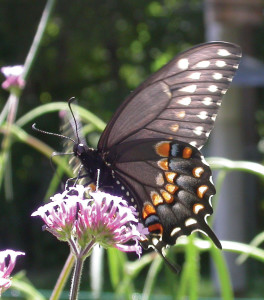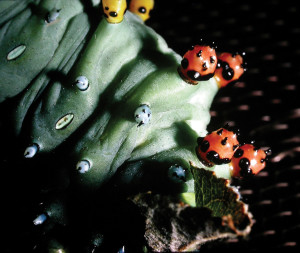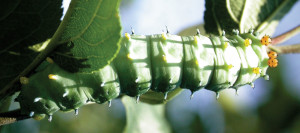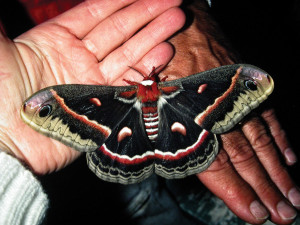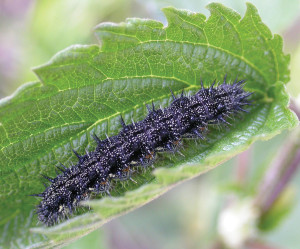Crawling Before They Fly
- Share
- Tweet
- Pin
- Share
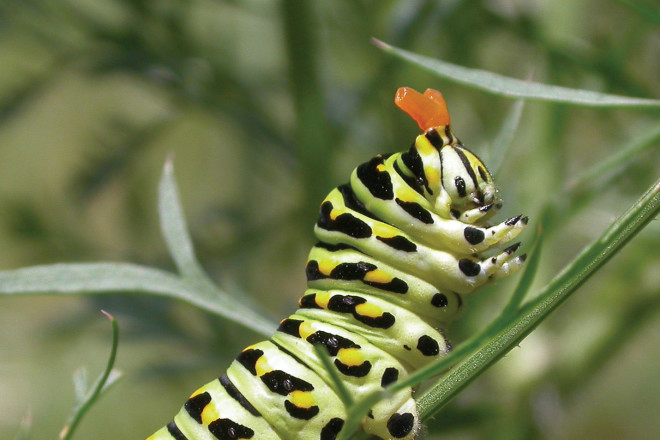
A turning point in my life with nature occurred when I was about eight or nine years old. My two older brothers and I had gone to spend the day playing at our grandparents’ home, which was “down the hill” from our house in Kewaunee. They had a wonderful yard and garden rich for exploring, and it was while we were in their garden that we saw two neighboring high school boys, Sylvester and August Ziemer, busy with their collecting nets chasing after butterflies in several backyards.
Eventually, they showed us some of their catches and also their rearing jars in which they were raising various caterpillars that had hatched from eggs laid by the butterflies they’d caught.
It turned out that in later years Sylvester amassed one of the finest butterfly collections in Wisconsin, representing over 60 years of his work, which was eventually donated in its entirety to the Invertebrate Zoology Department of the Milwaukee Public Museum. His brother August had become a self-taught butterfly (and especially moth) expert and worked his entire life in the Entomological Department of the Field Museum in Chicago. So, we brothers surely received a good beginning education from two budding experts. They taught us the basics of the complete life cycles of butterflies – from egg to caterpillar or larva, to chrysalis, and finally to adult – but, perhaps more importantly, they led us to realize the great natural beauty constantly surrounding us.
Our dad, who cared for a huge garden including a dozen or more fruit trees, also taught us how destructive some caterpillars could be. Fortunately, he didn’t use pesticides in our vegetable garden but did spend a lot of time picking and squashing Cabbage Loopers that were feasting on his broccoli and cabbage plants.
He did learn that unless he used pesticide sprays on his apple trees the ripening fruit would be wormy. It wasn’t until later years that I learned that one doesn’t bite into a wormy apple, it’s a caterpillary apple! The so-called “worms” are actually the small caterpillars of Coddling Moths. There are other misnamed destructive caterpillars including the Armyworm, Corn Earworm, Fall Webworm, and Tomato Hornworm. A caterpillar may be a young butterfly or a young moth, but a caterpillar is never a worm, no matter how many people call them worms.
Proportionately few caterpillars are pests. People in general would do well to develop a greater appreciation for the rich and varied insect biodiversity found in the Great Outdoors. One fact, too often overlooked and not considered, is the beneficial nature and importance of caterpillars in nature’s food webs and nutrient cycling. Many wild creatures depend upon caterpillars for food, including spiders, toads, beetles, birds, lizards, snakes, skunks and shrews.
Caterpillars are invertebrates, meaning simply that they have no skeletons. Their skins act as skeletons that hold their bodies together. From the time a butterfly or moth egg is hatched, this little creature becomes an “eating machine.” Eventually it eats so much that its skin is virtually filled up and it splits open, revealing the next so-called instar of its development. This new skin will enable the caterpillar to eat more and continue growing. Most moths and butterflies go through between four and seven instars or molts (most often five) before developing into a pupa or chrysalis which, in turn, becomes a moth or butterfly.
Most caterpillars have one of several kinds of natural defense. Some sport fiberglass-like hairs or spines, most of which are totally harmless to people. Many have unpleasant taste, such as the well-known Monarch Butterfly. (The caterpillars eat milkweed plants which contain very bitter and irritating glycosides that also help the caterpillar to taste very bad. Birds are quickly conditioned to not eat the Monarch caterpillars.) A few caterpillars have poisonous hairs which, when handled by people, can produce stings. Others have bright stripes and colors which are natural warnings to their predators, indicating “Don’t eat me!” A favorite of mine is the natural defense of the gorgeous Black Swallowtail butterfly caterpillar that, upon being attacked by a predator or gently teased with a little twig by a curious naturalist, can suddenly raise two fierce-appearing and fowl-smelling little “horns” on the front of its head.
One of the largest groups of moths is the family Geometridae (jee-o-MET-ri-dee), or the Geometers. Frequently the larvae are called measuring worms or inchworms, and the adults have beautiful and intricate geometrical markings on their wings. Most of the caterpillars are small, around one to two inches in length, and are camouflaged to resemble tiny twigs. One of the cold-tolerant Geometer moths we often see in late fall up against our lighted windows after dark is the Linden Looper. It is not uncommon to see this and other cold-weather moth species even after the first killing frost.
Caterpillars never bite and, actually, there is only one carnivorous caterpillar in North America, the small brown and tan Harvester Butterfly. The only “animals” it eats are Woolly Aphids. My all-time best butterfly and moth mentor was William “Bill” Sieker, a Madison attorney whose family cottage has been along the shore of Kangaroo Lake for many years. Bill was a member of the board of directors of The Ridges Sanctuary in later life and showed me where to find Woolly Aphids and what to look for in searching for the caterpillars of the Harvester Butterfly. The markings on this tiny caterpillar resemble the facial markings of a monkey – highly unusual.
Each spring we wait for one of the earliest butterflies, the Milbert’s Tortoise-shell, to appear in the front yard at our home. One of the several butterfly species that overwinter in the adult butterfly stage, they are eventually lured into feasting on the nectar of our tall Zinnias and other annual flowers. What’s quite fascinating about this species is that its host plant, upon which the caterpillars will eat, is one of two species of nettles that grow in Door County. A small patch of Stinging Nettles grows near our garden shed, does well from year to year, and in some summers sports hundreds of the eating and growing Milbert’s Tortoise-shell caterpillars. Many people would quickly destroy the Stinging Nettles without realizing that the plant is so important in the life cycle of these colorful little butterflies.
Door County is fortunate to have four species of the large Silkmoths – the Luna, Polyphemous, Promethea, and Cecropia – all dazzling to the eye and fascinating to study. During the early summer of 1959, I was slaving within the depths of despair, finishing my master’s degree classes and paper at the University of Wisconsin Madison. Much to my pleasant surprise a package arrived one day from my friends, the Hunters, who lived northwest of Green Bay and who loved nature as I did. The package held a plastic container which housed several twigs of mostly eaten Lilac leaves and two large, creepy, crawly Cecropia Moth caterpillars.
I soon had them in a clean gallon jar with some fresh Lilac leaves. How fortunate I was to be on hand the
moment one of the star-studded creatures, looking quite Christmas tree-like with its tiny yellow, blue, and orange “lights” and ornaments, began the long tedious task of forming its silken cocoon. It is an instinctive action – so intricate and methodical as to make you more reverent toward all life. It wasn’t until the following early summer that I watched in amazement as the adult Cecropia Moth emerged from its mummy-like cocoon.
John Gay summed it up perfectly when he wrote in 1727, “And what’s a butterfly? At best, He’s but a caterpillar dressed.”
Attract butterflies and moths to your yard by growing their host plants (be sure to keep your lawn, yard, shrubs and garden chemical free). Choose nectar-rich flowers (plants with distinctive shape, color and scent) that adult butterflies feed upon. Consider, for example, Zinnias, Milkweeds, Verbenas, Scabiosas, Hollyhocks, Salvias, Coneflowers and others.

